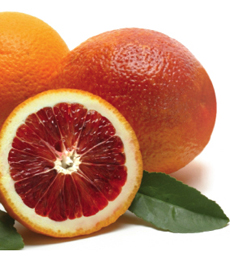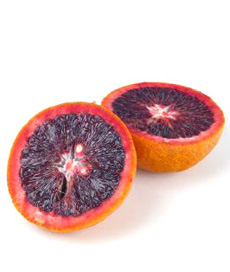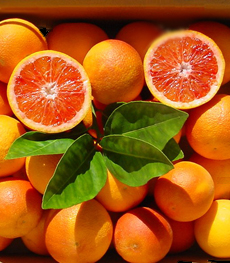
The Sanguinello variety of blood orange has a deep purple color. Photo courtesy Melissas.com.
December 2006
Last Updated March 2014
|
 |
Blood Oranges
Types Of Blood Oranges
Overview: Types Of Blood Orange
Delicious blood oranges have crimson or “blood”-colored flesh, the result of the pigment anthocyanin, not typically found in citrus, but common to other red fruits and flowers. Depending on the variety, the outside may look like a regular orange or feature telltale washes of red.
Blood oranges are believed to be a mutation of the sweet orange that occurred in southern Italy about 1850. The red hue is due to the antioxidant anthocyanin,* the same natural chemical that gives the pomegranate its color.
*Anthocyanin neutralizes the effects of free-radical chemicals that are believed to cause cancer and other ailments (diabetes, epilepsy, heart disease, liver disease and ulcers) plus the general impact of aging. Research shows that it fights and prevents cancerous tumors and ulcers, and improves vision. Blood oranges are also packed with high levels of carotene, dietary fiber, potassium and vitamin C.
The blood orange was brought to the U.S. by Italian immigrants and now grows in California, Florida and Texas. The season runs from October to January in Florida, from December to March in Texas and from November to May in California. There are three types of blood oranges. You can learn more about them; then scroll to the bottom of the page for related cooking videos.
A Rainbow Of Red Colors
The hue of a blood orange can range from red to rose to deep purple, depending on the variety and the climate where it was grown. Each variety has a different climate preference, and produces different sizes and flavors based on the climate, temperature and other factors impact the coloration and flavor intensity. Texas blood oranges tend to have less pigmentation; the humidity in Florida similarly limits the intensity of the pigment.
The three most popular cultivars (varieties) of blood orange the Moro, Sanguiello and Tarocco. The Ruby and the Palestine Jaffa can also be found. Other varieties of blood orange that are grown on a smaller scale.
- Moro, a recent introduction into the blood orange family, is grown in San Diego, California and in Texas. Round in shape, it is the most colorful of the three types, with a deep purple flesh and reddish orange rind (see photo above). It has a sweet flavor with notes of raspberry that makes this variety sing—whether in recipes or as an eating fruit. They are well worth seeking out.
- Palestine Jaffa Blood Orange, introduced to Texas in 1883 from Palestine (now Israel), is is considered by some to be a blood orange and by others to be a different variety entirely. It is seedless.
|
|

Moro variety of blood orange has a deep purple color. Photo by Josiah Gordon | SXC. |
- Ruby Blood Orange was brought from the Mediterranean to Florida, and then to California. Its blood coloration is not reliable and thus it has not become a popular variety.
- Sanguinello, discovered in Spain in 1929, has a reddish skin, has few seeds or is seedless, and has a sweet and tender flesh.
- Tarocco, native to Italy, is a medium-to large-size fruit and is perhaps the sweetest and most flavorful of the three types. It tends to be slightly elongated in shape. However, its internal color varies widely and is unreliably red.
|
|

Climate impacts the color. These Moro oranges grown in Texas have far less coloration than the classic Moro in the photo above. Photo courtesy LocalHarvest.org. |
Continue To Page 2: Blood Orange Recipes

|




